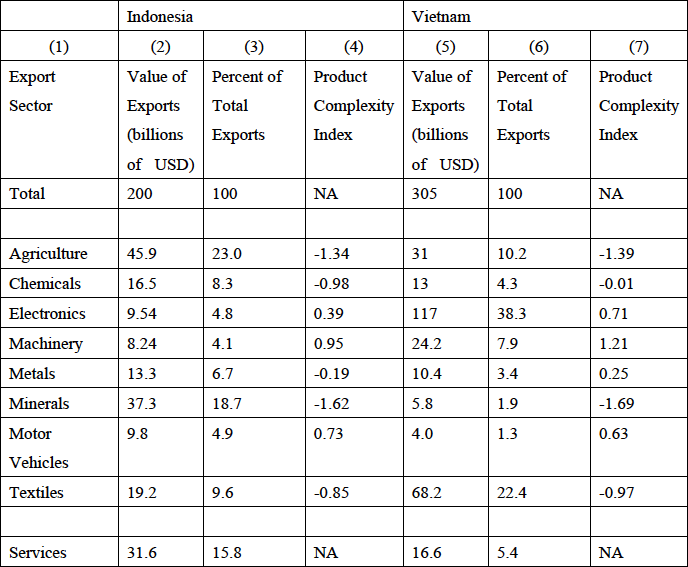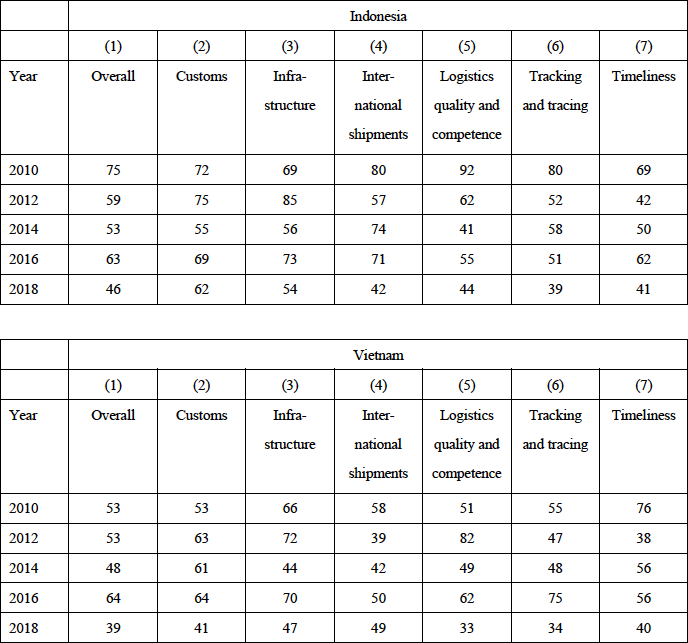| Author Name | Willem THORBECKE (Senior Fellow, RIETI) / KATO Atsuyuki (Research Associate, RIETI) |
|---|---|
| Download / Links |
This Non Technical Summary does not constitute part of the above-captioned Discussion Paper but has been prepared for the purpose of providing a bold outline of the paper, based on findings from the analysis for the paper and focusing primarily on their implications for policy. For details of the analysis, read the captioned Discussion Paper. Views expressed in this Non Technical Summary are solely those of the individual author(s), and do not necessarily represent the views of the Research Institute of Economy, Trade and Industry (RIETI).
Although Indonesia's economy has progressed over the last two decades, it has not successfully joined global value chains (GVCs) for electronics, other machinery or labor-intensive sectors such as textiles. On the other hand, Vietnam has multiplied its exports of electronics and textiles by integrating into GVCs. Foreign direct investment (FDI) could benefit Indonesia by increasing its resilience to external supply and price shocks and by providing opportunities to acquire foreign technology. We draw lessons from Vietnam on how Indonesia could attract FDI, diversify its export basket, and weather the COVID-19 pandemic.
Indonesia's export structure
Table 1 compares the export baskets of Indonesia and Vietnam in 2019. Indonesia's major exports are agriculture (23%), minerals (18.7%), services (15.8%), textiles (9.6%), and chemicals (8.3%). On the other hand, Vietnam's major exports include electronics (38.3%), textiles (22.4%), agriculture (10.2%), machinery (7.9%), and services (5.4%). ASEAN members have increased their exports of electronics over the last three decades by joining regional value chains. Vietnam successfully seized this opportunity but Indonesia has not. Indonesia's export basket remains unsophisticated, as measured for instance by the Product Complexity Index of Hidalgo and Hausmann (2009). On the other hand, Vietnam's export basket contains many sophisticated products. Vietnam has steadily improved in terms of the Hidalgo and Hausmann Country Complexity Index, from 107th out of 133 countries in 1995 to 52nd in 2019. By contrast, Indonesia stagnated, with its ranking falling from 55th in 2002 to 61st in 2019. FDI helps explain the differences in export structures between them. FDI into Vietnam has steadily increased and by 2020 reached 66% of GDP. In contrast, FDI in Indonesia was only 23% of GDP and less than half of this was in the manufacturing sector.
Impacts of COVID-19 on Indonesia and Vietnam
There are three reasons why Indonesia failed to join GVCs: 1. Adoption of protectionist policies using non-tariff measures (NTMs), 2. Poor human capital formation, 3. logistics problems. The Indonesian government harbored suspicions toward foreign investors because of colonial experiences. Investment in the mining and oil sector also caused the capital-intensive sector in Indonesia to expand while suppressing the small and medium sized enterprises (SMEs) that could support multinational enterprises (MNEs) in electronics. Many Indonesians were also distrustful of the globalization and liberalization recommended by international financial institutions (IFIs) after the Asian Financial Crisis (AFC) because of the perceived failures of the IFIs during the crisis. After President Suharto resigned in 1998, rent seeking by interest groups led to NTMs and other protectionist measures in Indonesia, which reduced its exports. By contrast, Vietnam achieved remarkable economic development through an integration into GVCs by liberalizing its economy, attracting FDI, and eliminating two-tiered exchange rates in the doi moi reforms, and using free trade agreements (FTAs) by harnessing external pressure to challenge domestic interests. For human capital formation, Indonesia amended its constitution in 2002 to mandate that the government spend at least 20% of its budget on education. The budget, however, has not produced quality results. Indonesia's is one of the worst performers on the Programme for International Assessment standardized tests, while Vietnam is one of the best performers. Indonesia also performs worse in terms of logistics than Vietnam and other ASEAN neighbors (please see Table 2).
Why has Indonesia failed to join GVCs?
Indonesia showed relatively better performance during the COVID-19 pandemic. Indonesia initially suffered more COVID-19 cases than Vietnam, and its GDP growth rate was -2% in 2020. In 2021, the growth rate recovered to 3.7% although the Delta variant significantly increased the number of cases. The aggregate stock market, which in theory equals the expected present value of future cash flows, had the same value on 11 February 2022 as it had on 18 February 2020 just before news of COVID-19 roiled stock markets. Stock prices also varied across sectors. Telecommunications equipment stock increased during the pandemic due to greater need for communications equipment. Commodity stocks such as industrial metals & mines, coal, and precious metals & mines largely gained due to foreign demand. On the other hand, automobiles and consumer sectors suffered large losses. The World Bank discussed how the loss of educational opportunities due to school closures could scar the Indonesian economy. Vietnam initially implemented a "No COVID" policy. This strategy imposed economic costs, with economic growth falling from 7.9% in 2019 to 2.9% in 2020. Vietnam shifted its strategy to a "Living with COVID" policy as infections multiplied during the Delta outbreak. The percent of fully vaccinated people rose from close to zero in May 2021 to almost 80% in February 2022. But the government also imposed lockdowns in the cities where infections significantly increased. Economic growth was volatile. The World Bank projects that the Vietnamese economy will grow by 5.5% in 2022, helped by factors such as supportive fiscal policy and the central bank's encouragement for commercial banks to reduce or eliminate interest rates and provide loan forbearance. The aggregate stock market grew during the pandemic due to a significant increase in the prices of commodity stocks and the strong performance of exporting sectors such as clothing and telecommunication equipment. On the other hand, travel and leisure stocks performed badly.
Several recommendations for Indonesia
Indonesia is hampered from attracting FDI by logistics weaknesses, high redundancy costs, protectionism, and ineffective education. To address these problems, Indonesia should learn from Vietnam. Vietnam has used FTAs to resist cronyism and domestic protectionist pressures. Indonesia should focus on attracting "Japanese-style" FDI that promotes learning. It should also invest in human capital. As the World Bank notes, schools should emphasize cognitive skills, social skills, and adaptive skills, and improve access to the internet to promote the digital economy. Parents and teachers should support distance learning to offset the loss of educational opportunities arising from the pandemic. Finally, Indonesia should improve the business climate to encourage entrepreneurship.


- Reference(s)
-
- Hidalgo, C. A., & Hausmann, R. 2009. The Building Blocks of Economic Complexity. Proceedings of the National Academy of Sciences, 106, 10570–10575.

